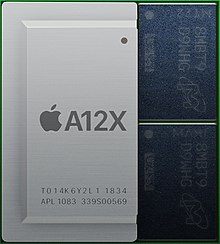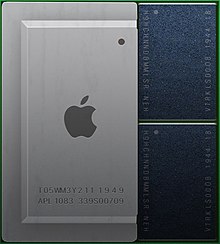 | |
| General information | |
|---|---|
| Launched | A12X: October 30, 2018 A12Z: March 18, 2020 |
| Discontinued | A12X: March 18, 2020 A12Z: April 20, 2021 |
| Designed by | Apple Inc. |
| Common manufacturer(s) | |
| Product code | APL1083 [2] |
| Max. CPU clock rate | to 2.49 [3] GHz |
| Cache | |
| L1 cache | 128 KB instruction, 128 KB data |
| L2 cache | 8 MB |
| Architecture and classification | |
| Application | Mobile |
| Technology node | 7 nm [4] |
| Microarchitecture | Vortex and Tempest |
| Instruction set | A64 – ARMv8.3-A |
| Physical specifications | |
| Cores |
|
| GPU(s) | Apple-designed integrated graphics A12X: 7 core GPU |
| Products, models, variants | |
| Variant(s) | |
| History | |
| Predecessor(s) | Apple A10X |
| Successor(s) | Apple M1 |

The Apple A12X Bionic is a 64-bit system on a chip (SoC) designed by Apple Inc. It first appeared in the iPad Pro (3rd generation), announced on October 30, 2018. [4] The A12X is an 8-core variant of the A12 (four big cores, four small cores) and Apple states that it has 35 percent faster single-core CPU performance and 90 percent faster overall CPU performance than its predecessor, the Apple A10X. [4] The Apple A12Z Bionic is an updated version of the A12X, adding an additional GPU core, and was unveiled on March 18, 2020, as part of the iPad Pro (4th generation). [5] [6]
Design
The A12X and A12Z feature an Apple-designed 64-bit ARMv8.3-A octa-core CPU, with four high-performance cores called Vortex and four energy-efficient cores called Tempest. [4] [1] The Vortex cores are a 7-wide decode out-of-order superscalar design, while the Tempest cores are a 3-wide decode out-of-order superscalar design. The Tempest cores are based on Apple's Swift cores from the Apple A6, and are similar in performance to ARM Cortex-A73 CPU cores. [7] [8] It is Apple's first SoC with an octa core CPU. [1]
The A12X integrates an Apple-designed 7-core graphics processing unit (GPU), with twice the graphics performance of the A10X. [4] The A12Z has an 8-core GPU, one more core than the A12X, enabling better performance in 4K video editing, rendering, and augmented reality. [9] [10] Embedded in the A12X and A12Z is the M12 motion coprocessor. [11] The A12Z additionally features tuned performance controllers and a better thermal architecture compared to the A12X, which potentially allows for higher clock speeds. [12] The A12X and A12Z include dedicated neural network hardware that Apple calls a "next-generation Neural Engine". [4] This neural network hardware, which is the same as found in the A12, [1] can perform up to 5 trillion operations per second. [4]
The A12X and A12Z are manufactured by TSMC using a 7 nm FinFET process, and it contains 10 billion transistors [1] [4] vs. the 6.9 billion on the A12. [13] The A12X is paired with 4 GB of LPDDR4X memory in the third-generation 12.9" iPad Pro and the first-generation 11" iPad Pro, or 6 GB in the 1 TB storage configurations. [14] [2] The A12Z is paired with 6 GB of LPDDR4X RAM in the fourth-generation 12.9" iPad Pro and the second-generation 11" iPad Pro. [15]
The A12X has video codec encoding support for HEVC and H.264. It has decoding support for HEVC, H.264, MPEG‑4, and Motion JPEG. [16]
Developer Transition Kit (2020)
At its 2020 Worldwide Developer's Conference, Apple introduced the Developer Transition Kit (2020), which uses the A12Z processor with 16 GB RAM in a Mac mini enclosure, hence being the first Macintosh computer to use the Apple silicon architecture. [17]
The A12Z would be used as the basis for the design of the M1, Apple's first in-house processor designed for use in Mac computers. In an interview shortly after the introduction of the DTK (2020), Apple's SVP of Software Engineering Craig Federighi commented:
“Even that DTK hardware, which is running on an existing iPad chip that we don’t intend to put in a Mac in the future – it’s just there for the transition – the Mac runs awfully nice on that system. It’s not a basis on which to judge future Macs ... but it gives you a sense of what our silicon team can do when they’re not even trying – and they’re going to be trying.” [18]
Products that include the Apple A12X and A12Z Bionic
A12X Bionic
A12Z Bionic
- iPad Pro 11-inch (2nd generation)
- iPad Pro 12.9-inch (4th generation)
- Developer Transition Kit (ARM, 2020)
See also
- Apple silicon, the range of ARM-based processors designed by Apple.
- Apple A12
References
- ^ a b c d e f Frumusanu, Andrei (October 30, 2018). "Apple Announces New 11" and 12.9" iPad Pros with A12X SoC". AnandTech. Archived from the original on October 30, 2018. Retrieved October 30, 2018.
- ^ a b "iPad Pro 11" Teardown". iFixit. November 12, 2018. Archived from the original on December 5, 2018. Retrieved November 12, 2018.
- ^ "iPad8,8 – Geekbench Browser". Geekbench. Archived from the original on November 13, 2018. Retrieved November 12, 2018.
- ^ a b c d e f g h "New iPad Pro with all-screen design is most advanced, powerful iPad ever" (Press release). Apple Inc. October 30, 2018. Archived from the original on October 30, 2018. Retrieved October 30, 2018.
- ^ "Looking at the Apple A12Z Bionic System on Chip | TechInsights". www.techinsights.com. Archived from the original on December 9, 2020. Retrieved August 30, 2020.
- ^ Miller, Chance (March 18, 2020). "Apple unveils new iPad Pro with backlit Magic Keyboard case, available to order today". 9to5Mac. Archived from the original on March 18, 2020. Retrieved March 18, 2020.
- ^ Frumusanu, Andrei. "The iPhone XS & XS Max Review: Unveiling the Silicon Secrets". www.anandtech.com. Archived from the original on January 26, 2021. Retrieved January 27, 2019.
- ^ Frumusanu, Andrei. "Apple iPhone XS Review Addendum: Small Core and NN Performance". www.anandtech.com. Archived from the original on November 9, 2020. Retrieved May 1, 2019.
- ^ Miller, Chance (March 26, 2020). "Report claims new iPad Pro's A12Z Bionic chip is just a 'renamed A12X with an enabled GPU core'". 9to5Mac. Archived from the original on March 27, 2020. Retrieved March 29, 2020.
- ^ Clover, Juli (April 13, 2020). "A12Z Chip in iPad Pro Confirmed to Be Same As A12X, But With Extra GPU Core Enabled". MacRumors. Archived from the original on April 14, 2020. Retrieved April 14, 2020.
- ^ "iPad Pro Technical Specifications". Apple Inc. October 30, 2018. Archived from the original on October 30, 2018. Retrieved October 30, 2018.
- ^ Shilov, Anton. "Apple Unveils New iPad Pro: A12Z Bionic, Camera w/ Depth Sensor for AR, Keyboard w/ Trackpad". www.anandtech.com. Archived from the original on March 29, 2020. Retrieved March 30, 2020.
- ^ Summers, Nick (September 12, 2018). "Apple's A12 Bionic is the first 7-nanometer smartphone chip". Engadget. Archived from the original on September 13, 2018. Retrieved September 12, 2018.
- ^ Axon, Samuel (November 7, 2018). "2018 iPad Pro review: "What's a computer?"". Ars Technica. Condé Nast. Archived from the original on January 26, 2021. Retrieved November 12, 2018.
- ^ Espósito, Felipe (March 18, 2020). "All 2020 iPad Pro models feature 6 GB of RAM, same U1 chip as iPhone 11". 9to5Mac. Archived from the original on March 19, 2020. Retrieved March 18, 2020.
- ^ "iPad Pro 11-inch (1st generation) - Technical Specifications". support.apple.com. Retrieved November 5, 2022.
- ^ "Apple announces Mac transition to Apple silicon". Apple Newsroom. Archived from the original on June 23, 2020. Retrieved August 30, 2020.
- ^ Gruber, John (June 24, 2020). "The Talk Show Remote from WWDC 2020, With Craig Federighi and Greg Joswiak". Daring Fireball. Archived from the original on November 1, 2020. Retrieved June 25, 2020.